On the opening day of the season, Manchester United put four past Chelsea, as they opened their campaign with a 4-0 win over their rivals. Since then much has changed, and Frank Lampard has Chelsea sitting in the Champions League places, whilst Manchester United sit seven points behind them.
This was Chelsea’s first chance to avenge the previous result, yet United managed to seal a 2-1 win courtesy of an otherworldly free-kick from Marcus Rashford as well as a penalty from the young English forward too.
This tactical analysis focuses on the tactics used by both sides in this EFL Cup clash.
Lineups
Ever since Sir Alex Ferguson became the first manager to rest players for the EFL Cup, it has become a relatively commonplace practice. It is understandable with the build-up of European fixtures at this time of year, as well as the busy Christmas period looming around the corner, to put the EFL Cup at the bottom of the priority list. However, it’s nevertheless an excellent chance to win some silverware early in the season that could springboard a team’s form for the remainder of the year.
Both Chelsea and United fielded sides that were a mixture of first-team regulars, youngsters, and squad players who have been short of first-team football.
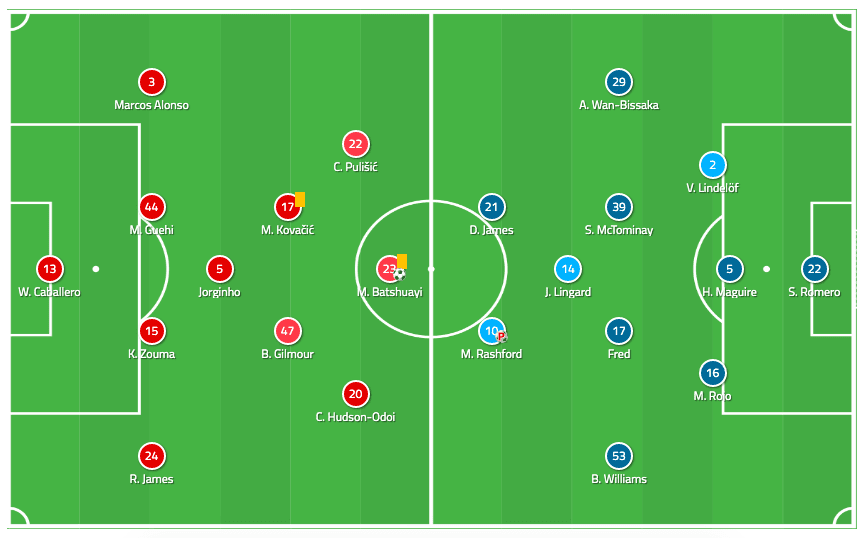
Ole Gunnar Solskjaer fielded a 3-4-1-2 formation, making it the third time they have used this formation in their last four games, with Marcos Rojo coming into the side to play alongside Harry Maguire and Victor Lindelöf. Academy product Brandon Williams and Aaron Wan-Bissaka played as wing-backs, whilst a midfield three was made up of Scott McTominay, Jesse Lingard and Fred. The latter are two players who are no doubt desperate to nail down a starting berth in the middle of the park once more, alongside their Scottish teammate. If fielding a formation which allowed United to protect the middle of the pitch, whilst also allowing their defence to form a back five, wasn’t enough of a clue that Solskjaer was looking to play counter-attacking football, then perhaps United’s chosen front two were a good clue. They opted for the endless running and pace of Daniel James, next to the equally quick Marcus Rashford.
United remained in this 3-4-1-2 formation until Chelsea’s equalizer. Following Michy Batshuayi’s goal, Solsjkaer switched to a 4-2-3-1, bringing Lindelöf off and bringing on Anthony Martial.
Lampard responded to this by changing to a 4-2-3-1 himself, bringing Christian Pulisic off and replacing him with Pedro, who is a more disciplined winger than his talented but sometimes defensively-naive American teammate.
Frank Lampard initially fielded a 4-3-3, keeping the inform Pulisic in the front three, next to Batshuayi and Callum Hudson-Odoi. In midfield Billy Gilmour was given the chance to impress, playing next to first-team regulars Mateo Kovačić and Jorginho, whilst in defence Lampard gave yet another academy product a first-team appearance with Marc Guehi partnering Kurt Zouma at the heart of the defence, whilst Marcos Alonso and Reece James manned the flanks.
Chelsea’s build-up play
We can see from analysing Chelsea’s pass map that they predominantly used their wings to attack United, and with United’s middle three, clearly struggled to get regular service into Batshuayi, or Tammy Abraham who replaced him. There was a lot of lateral passing with Jorginho and Kovačić comprising Chelsea’s fourth highest pass link, as well as their top three pass links being made up of defenders.
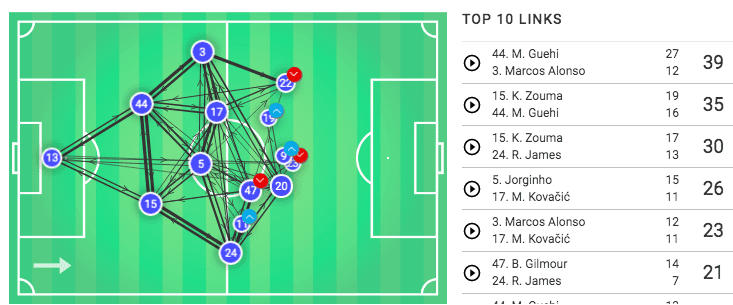
Both of their holding midfielders were vital to their entire attacking approach. As Chelsea pushed forward, both Kovačić and Jorginho sat deep and anchored their shape. In doing so they were able to act as pivots as well as restart any attacks should United hack a ball away in defence.
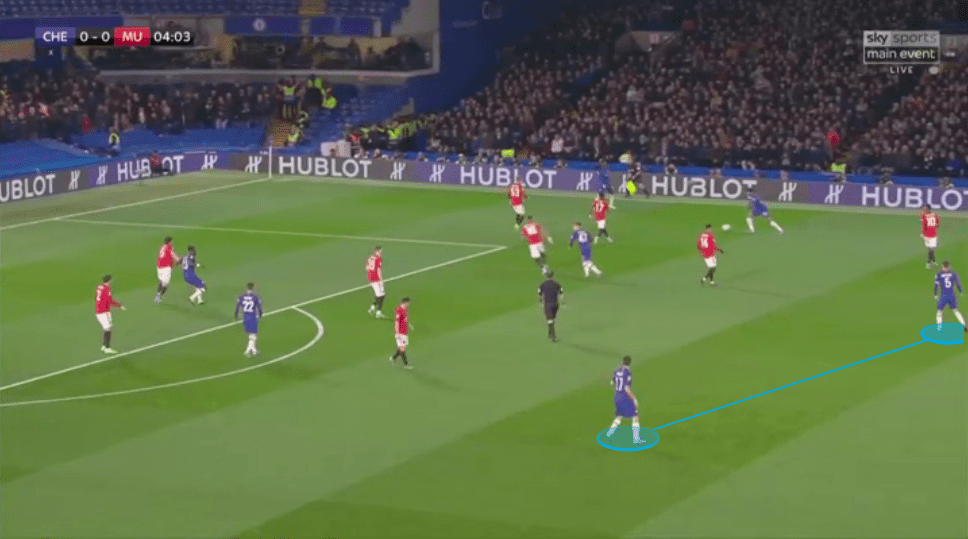
By these two dropping back and acting as pivots it allowed the full-backs to push high and provide width to the Chelsea attack. Both Marcos Alonso and James took up areas that would normally be occupied by orthodox wingers.
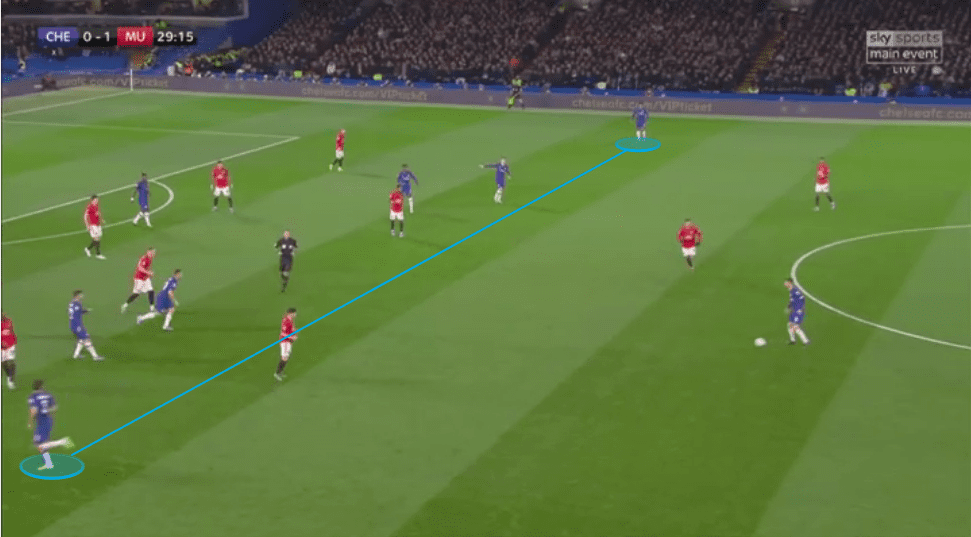
With Marcos Alonso and James occupying these wide areas in attack it allowed Pulisic and Hudson-Odoi the opportunity to stay inside and occupy the half-spaces. This was vital with United dropping five back to defend, in order to break them down. Due to the clutter of players in central areas though, it is no wonder that the majority of Chelsea’s attacking play came down the flanks.
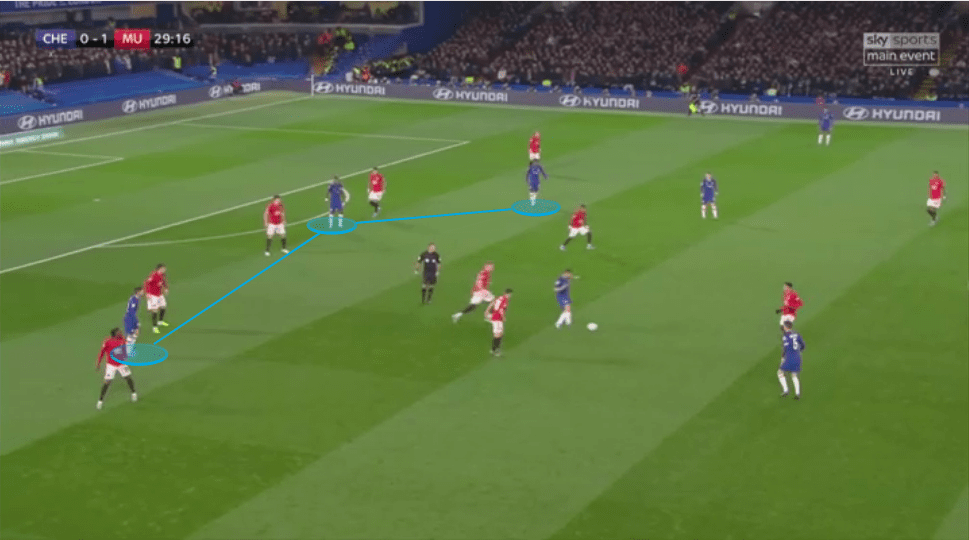
With United defending deep and protecting the centre of the pitch so effectively it meant the majority of Chelsea’s shots came from outside the box. Disappointingly despite having 12 shots, they enjoyed just a 0.05 xG per shot.
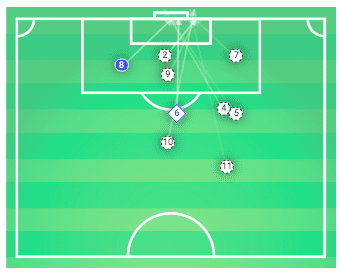
Chelsea’s goal came from being able to hit the United defence with a direct ball, who it is fair to suggest perhaps lost concentration. All three of United’s centre-backs were unable to deal with the quick break, and decided against making a tactical foul and taking the yellow card.
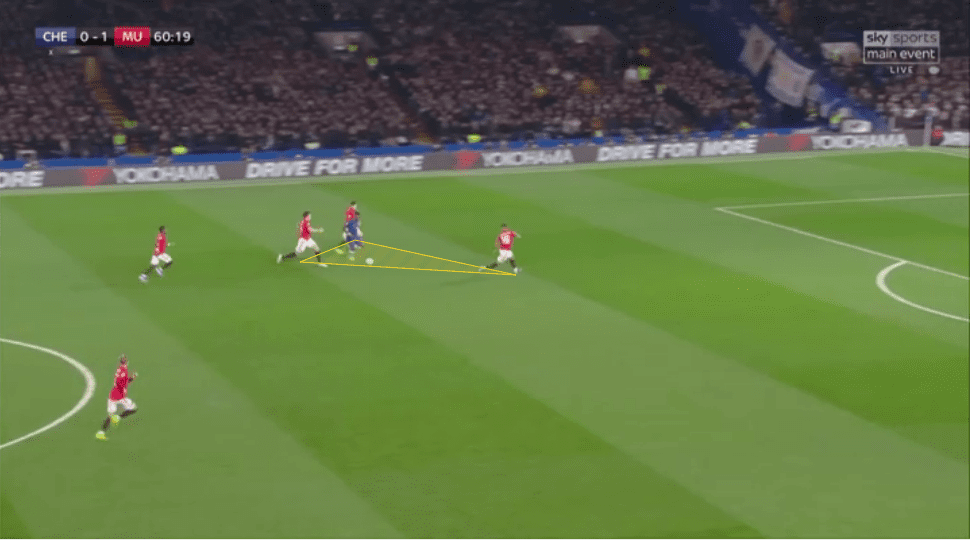
Batshuayi was able to guide his way through the mess of United’s back three and score. This was incredibly disappointing for United who had defended with such discipline until this point. It wouldn’t have been a shock to see them fold at this point, however, they were able to regain their poise and defend the lead once more after Rashford’s second goal of the game.
Manchester United’s defensive tactics
United were able to prevent Chelsea playing penetrative passes, with Lampard’s side playing 31% of their passes laterally.
They were excellent in restricting Chelsea to an 18% shooting accuracy and only one shot in the first half. They also made an astonishing 66 interceptions and 22 clearances.
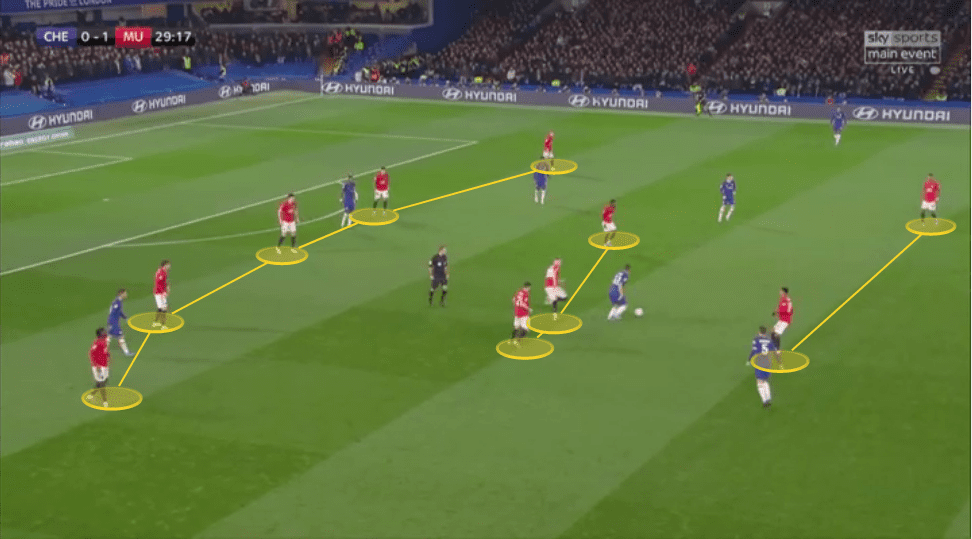
The analysis above shows how United dropped into a 5-3-2 formation when defending deep. Lingard lined up as the attacking midfielder in the midfield three, however, United were fluid with the personnel within their shape, and Rashford or James also dropped in at times with Lingard staying higher instead.
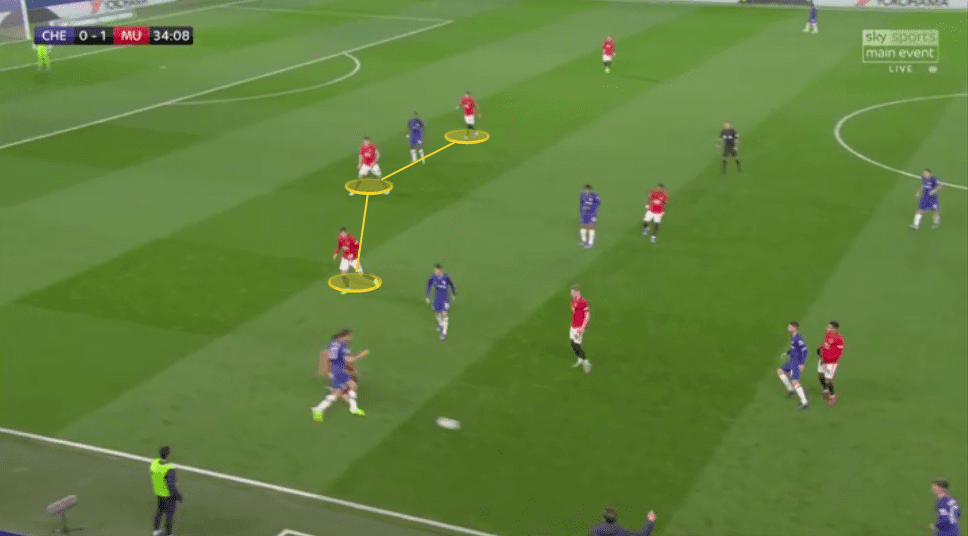
When the ball was in wide areas, United’s back three ultimately stayed tight, however, two centre-backs, in particular, were always left to ensure Batshuayi was starved of service. Having the extra centre-back meant Batshuayi could be marked comprehensively, whilst ensuring there was always one player spare centrally to deal with the wide forwards playing in the half-spaces, as the image above highlights.
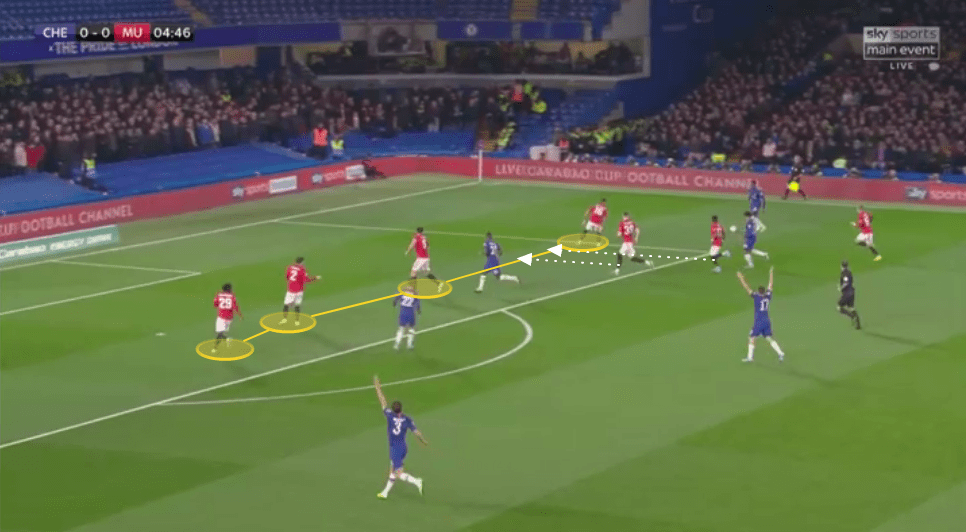
United valued dropping players very deep whilst defending Chelsea’s breaks, and flooded the central areas and their own 18-yard box with bodies in order to prevent easy shooting opportunities for the hosts. In the image above McTominay looks to drop into the backline despite Chelsea having numbers waiting on the edge of the box. Solsjkaer’s men were seemingly happy to allow chances from further out as long as they had plenty of men behind the ball in defence.
United had far less of the ball, registering 35% of possession but still looked to win the ball back early. However, it wasn’t necessarily an intense press. They had a PPDA of 10.28, with their focus more on closing passing lanes, rather than pressing the passer itself. However, Rashford, Lingard and James were able to use their pace and persistence to win back possession in high areas should the opportunity present itself. 17% of United’s ball recoveries came in high areas, which was more successful than Chelsea who pressed with a good intensity throughout, with a PPDA of 6.58, yet only 10% of their ball recoveries came in high areas.
When pressing from the front, Lingard would push up and join Rashford and James to attempt to win the ball back early. However, United always wanted three in midfield, and when Lingard pushed up, the visitors pushed one of their three centre-backs forward, usually Lindelof, in order to make up the numbers and prevent there being space in the middle of the pitch for Chelsea to exploit.
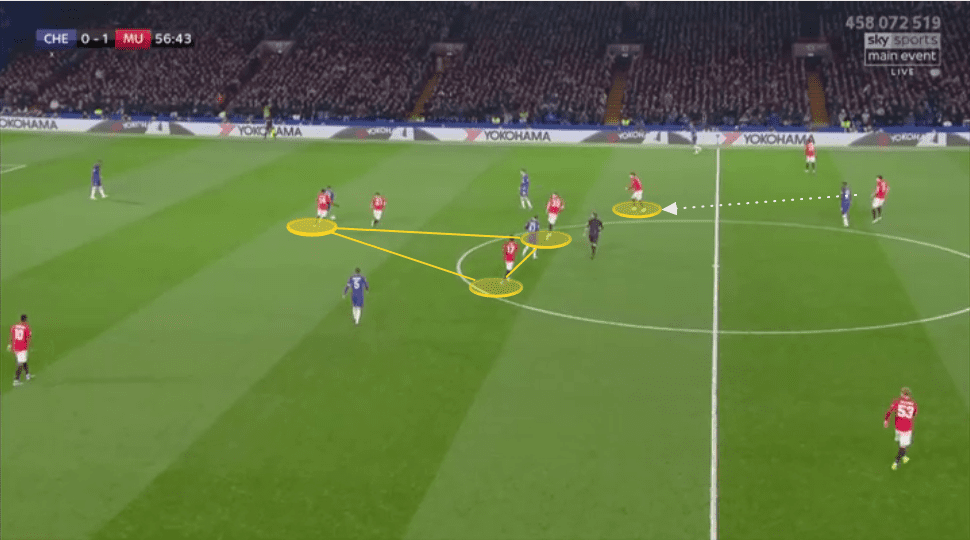
United’s attack
United were purposeful and direct in their approach. Despite making only 328 passes over the course of the game, almost half of Chelsea’s total of 650, they still managed to create chances going forward and were deserved winners on the night.
From looking at United’s pass map we can see how important Fred was to their build-up play. Of their top five pass links, Fred was involved in three of these and his ability to feed Rashford more easily than Chelsea were able to feed Batshuayi was a key difference between the two sides going forward. Fred enjoyed a 91% pass completion.
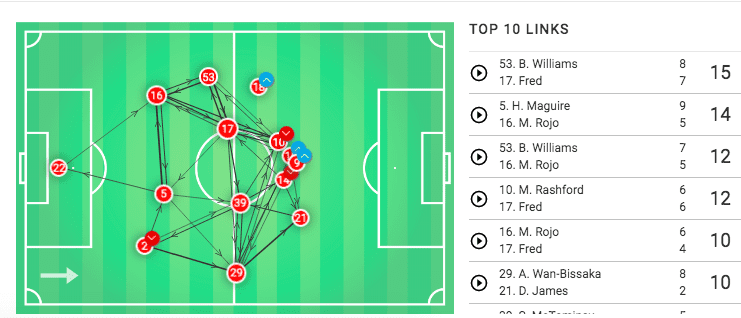
United broke quickly, using the pace of their front two and Lingard, as well as both wing-backs Williams and Wan-Bissaka, to carry the ball at speed. This was their primary tactic to get the ball forward from their defensive third, and the long ball was sparsely used, their average pass length being 18.75 yards, just over a yard less than Chelsea’s own average.
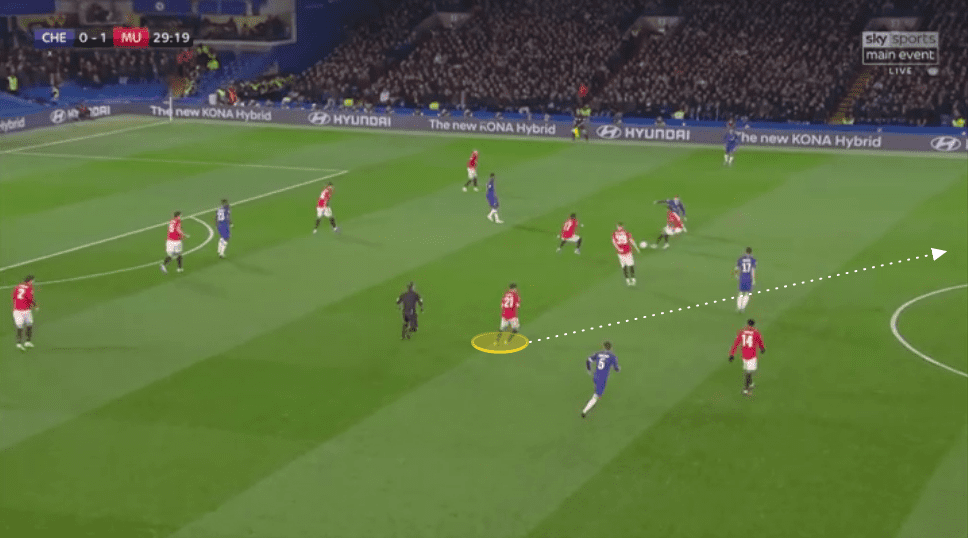
James would often drop into the midfield and was excellent at transitioning quickly into the forward line once United had regained possession. In the image above United have just won the ball back in the middle of the pitch and James has dropped back to support. As soon as it was won back the young Welshman was instructed to sprint forward as quickly as possible so United always had at least a front two when attacking.
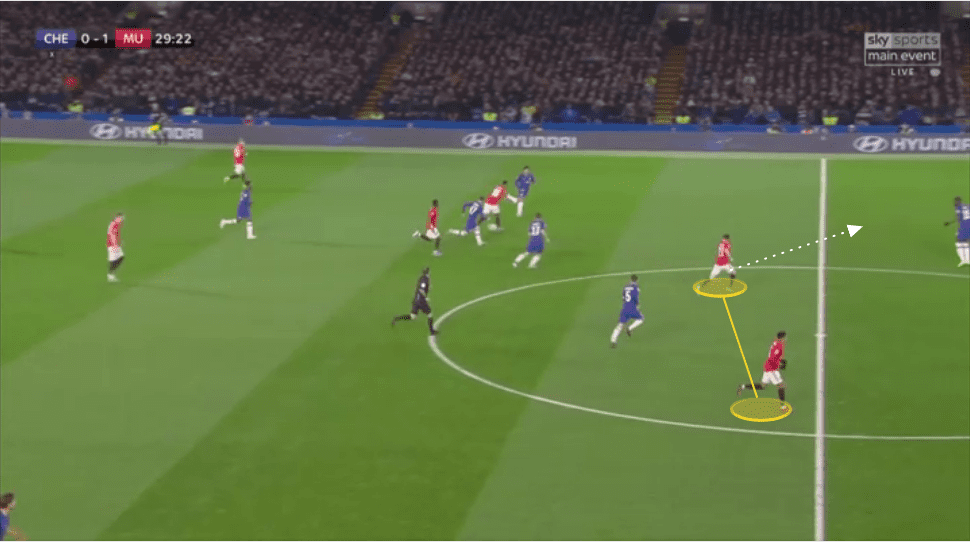
Despite only having eight efforts on goal, United created good chances and had an xG per shot of 0.14, almost triple Chelsea’s. United also registered one more shot on target than Chelsea even though they took three fewer shots overall.
Conclusion
Lampard will be disappointed to not see his side progressing into the next round. Even though they dictated the tempo of the game and enjoyed the majority of possession, Chelsea struggled to find a way past Manchester United’s organized defence.
United were patient and purposeful in how they approached this game and now find themselves ina quarter-final of a cup competition. In Ferguson’s first season it was famously the FA cup win that kept him in his job. Solsjkaer may well need something similar.
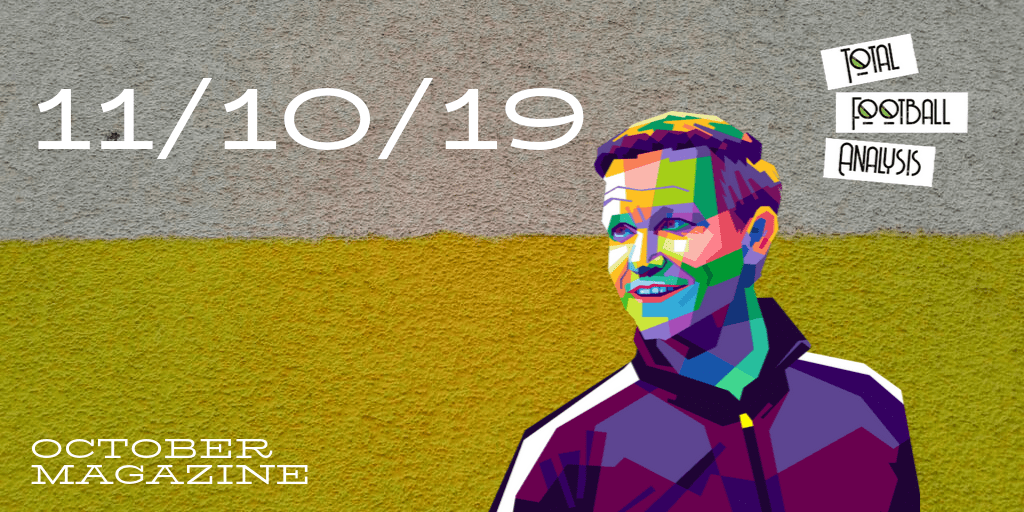
If you love tactical analysis, then you’ll love the digital magazines from totalfootballanalysis.com – a guaranteed 100+ pages of pure tactical analysis covering topics from the Premier League, Serie A, La Liga, Bundesliga and many, many more. Buy your copy of the October issue for just ₤4.99 here




Comments